Module 8 - Indigenous Self-Determination
1/47
There's no tags or description
Looks like no tags are added yet.
Name | Mastery | Learn | Test | Matching | Spaced |
|---|
No study sessions yet.
48 Terms
Indigenous knowledge
________________ - is made up of deep and complex systems of knowing developed over time by a particular people in a particular area— Passed down from generation to generation.
Built by specific people in specific places over time.
It includes languages, ceremonies, cultural practices, and oral traditions.
Strongly connected to Mother Earth (also called “earth knowledge”).
Sage ceremony
Traditional ceremonies
__________ - a spiritual practice involving burning sage to cleanse and purify a space, object or people:
Connect people to Mother Earth.
Help people understand and respect Indigenous ways of knowing.
Are part of starting in a good, respectful way.
Key qualities of Indigenous knowledge
Indigenous knowledge
_______________ - Indigenous knowledge is:
Holistic: Sees everything as connected.
Adaptive & Dynamic: Always changing and growing.
Cumulative: Built over time.
Intergenerational: Passed down through families.
Spiritual: Linked to ancestors and the land.
Observant: Based on close watching of nature.
Responsible: Focused on caring for the land and future.
Moral: Teaches values like respect, balance, and responsibility.
Nonlinear: Not step-by-step—more circular and interconnected.
Relative: Meaning can change based on place and culture.
Unique: Each community’s knowledge is different.
Humble: Recognizes humans are only part of the system.
Valid: Just as important as scientific knowledge.
Irreplaceable and Invaluable: You can’t replace it, and its value can’t be measured.
Indigenous Knowledge Systems (IKS)
Indigenous knowledge
_____________ - ways of understanding the world based on relationships, balance, and respect for nature
They are holistic, meaning they connect physical, mental, emotional, and spiritual life.
These systems adapt and grow over time and are passed down through stories, traditions, and hands-on teaching.
IKS are different from Western knowledge, but both can work together to solve problems like health care and climate change.
How Indigenous knowledge is passed down
Indigenous knowledge
_______________ - Indigenous knowledge is shared in both formal and informal ways, like:
oral narratives that recount human histories;
cosmological observations and modes of reckoning time;
symbolic and decorative modes of communication;
techniques for planting and harvesting;
hunting and gathering skills;
specialized understanding of local ecosystems;
how to manufacture specialized tools and technologies (i.e. hide tanning, pottery-making, concocting medicinal remedies, etc.).
Indigenous vs. Western Knowledge
__________- major differences
Indigenous knowledge is spiritual, based on experience, and sees all things as connected.
Western knowledge is scientific, based on proof, and often separates things into parts.
Indigenous time is circular (seasons, cycles); Western time is linear (past → future).
Indigenous knowledge values sharing, community, and land as sacred; Western knowledge often values individual success and using land for resources.
But both value honesty, learning from the world, and adapting over time.
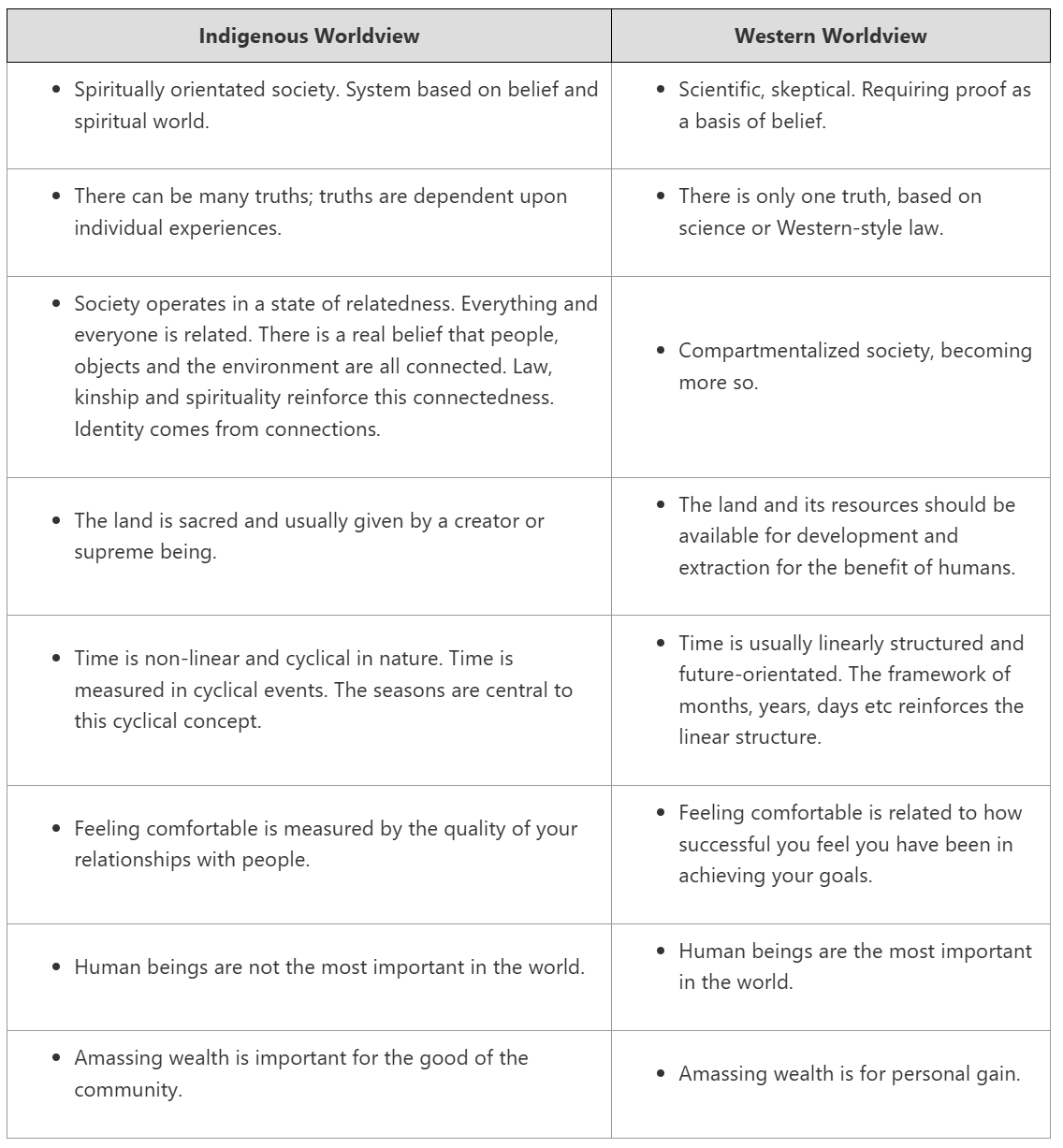
Circle as a symbol for Indigenous knowledge
_________________ - a powerful symbol in Indigenous cultures, representing cycles of life, interconnectedness, and balance.
illustrates the circular nature of knowledge, where learning and growth occur continuously and inclusively. In this context, we can visualize two overlapping circles: one representing Indigenous knowledge and the other representing Western knowledge.
Both systems have their own strengths and scientific principles, yet they intersect in meaningful ways that highlight shared values and complementary approach
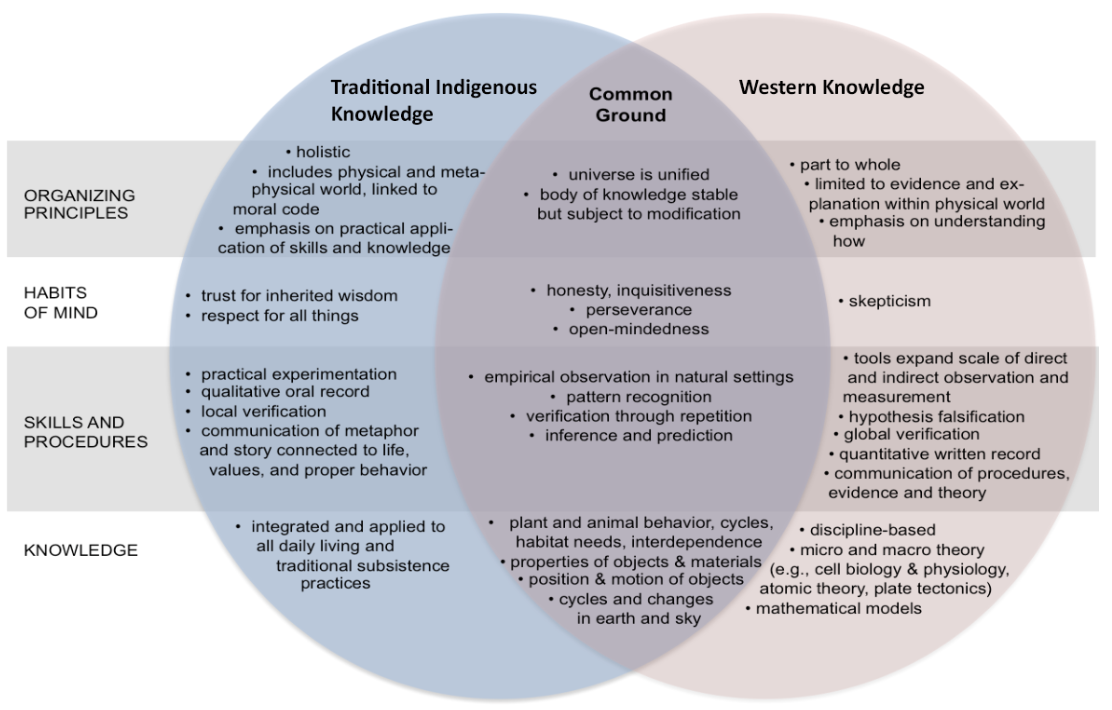
Five Circles Model (FNHA)
______________ - Created by the First Nations Health Authority, this model shows health as connected:
Physical, mental, emotional, and spiritual health all matter
Family, community, and nature affect wellness
Elders and traditional teachings guide the journey
It’s a circle of connection between self and everything around you.
A Hunter’s Story
___________________-This story shows how hunting was about more than survival—it was about learning from Elders, working together, and sharing with the whole community.
Respect came from being generous. It also shows how knowledge was passed down by doing, not just telling.
Today, some things have changed (like using skidoos instead of snowshoes), but the values of sharing and learning from the land still matter.
Inuit knowledge
IQ
_____________- the beliefs, skills, and stories passed down by Inuit people. It includes oral storytelling, hunting, medicine, and values. It teaches that the past and present are connected, and culture must be protected and shared with future generations.
Inuit live mainly in four regions of Canada: Inuvialuit (NWT/Yukon), Nunavik (Northern Quebec), Nunatsiavut (Labrador), and Nunavut.
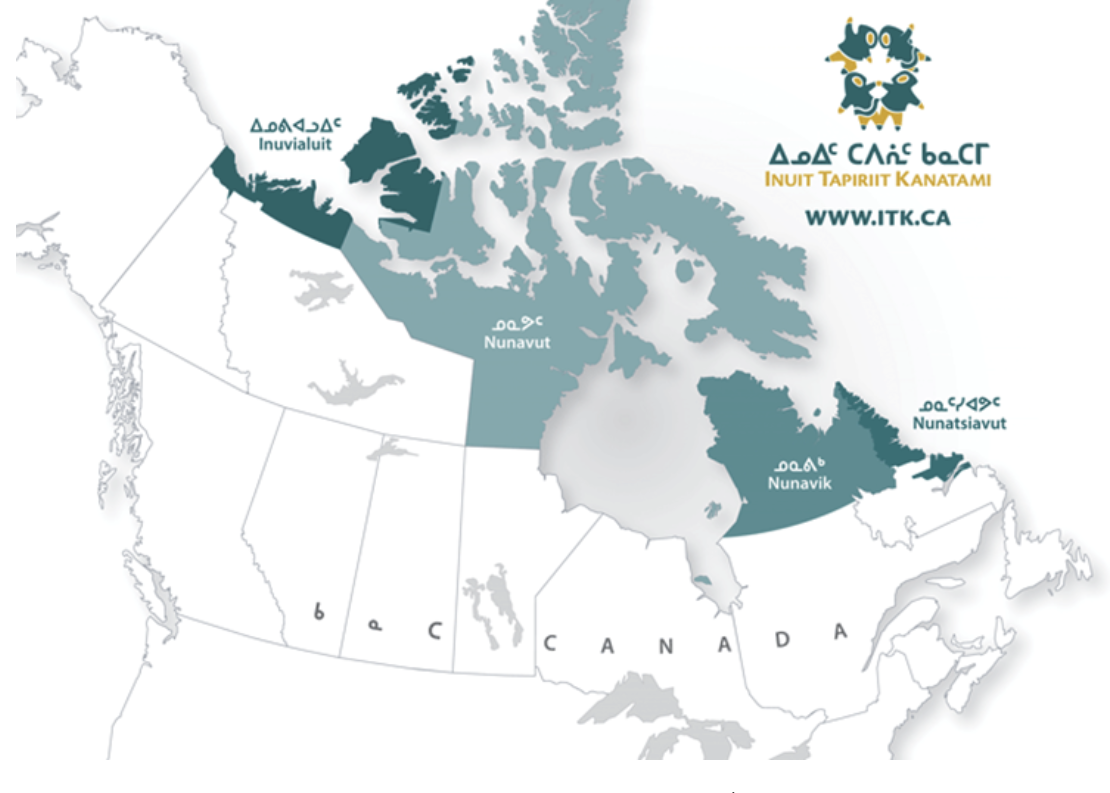
Inuit Qaujimajatuqangit— IQ
_______________ - means “Inuit Traditional Knowledge.” It includes values, skills, and ways of thinking.
It focuses on living a good life through four big laws (maligait):
Work for the common good
Respect all living things
Keep harmony and balance
Plan and prepare for the future
IQ Principles
IQ
_______________ - The Government of Nunavut uses eight IQ values to guide life:
Inuuqatigiitsiarniq – Respecting others and caring for people
Tunnganarniq – Being welcoming and inclusive
Pijitsirniq – Serving family and community
Aajiiqatigiinniq – Making decisions through group discussion
Pilimmaksarniq – Learning skills by watching and practising
Ikajuqtigiinniq – Working together
Qanuqtuurniq – Being creative and resourceful
Avatittinnik Kamatsiarniq – Caring for the land and animals
Inuit knowledge supports emotional, spiritual, mental, and physical health. It gives people a strong identity, support from the community, and a sense of belonging. These are all needed for long-term well-being
Types of knowledge holders
Knowledge holders
_________________ - three main types:
Contemporary traditional knowledge holders
Ceremonial traditional knowledge holders
Osakapiwis (Elder helpers)
1) Contemporary traditional knowledge holders
Types of knowledge holders
____________ - Provide insight and guidance within a traditional context
2) Ceremonial traditional knowledge holders
Types of knowledge holders
____________ - Often speak Indigenous languages and conduct ceremonies such as sweatlodge and pipe ceremonies
Conduits: Can see prophecies, being able to connect and hear from the creator
Model what you want them to hear
3) Osakapiwis (Elder helpers)
Types of knowledge holders
____________ - Are apprentices learning directly from a Knowledge Holder.
Knowledge holders
_______________ - (or Knowledge Keepers) are individuals who preserve and share Indigenous knowledge.
They are not defined by age but by the level of knowledge they possess.
Their role is to pass down traditions, customs, laws, and spirituality within their communities. They ensure cultural practices are maintained across generations.
Role of knowledge keepers
Knowledge holders
________________ - serve as spiritual guides and cultural teachers. They aim to bring balance and harmony to their communities.
Unlike conversion-focused traditions, Knowledge Holders do not try to change others’ beliefs but seek respect and understanding from those unfamiliar with Indigenous customs.
Offering tobacco
Traditional ceremonies
________________ - a traditional way of honoring and acknowledging Knowledge Holders’ wisdom
This gesture holds deep spiritual significance beyond its material value, especially in places like Saskatchewan. It is an act of respect to the knowledge and teachings being shared.
Knowledge holders in research
Knowledge holders — research
____________ - they share insights into the unique aspects of Indigenous knowledge systems and help preserve and pass down this wisdom. They also guide research to ensure it respects cultural practices and values.
Indigenous health research
______________ - Research that respects and integrates Indigenous ways of knowing, leadership, values, and ethics. It bridges Indigenous and Western methods to transform lives and shape public policy for ethical, inclusive health practices.
Medicine Wheel model
_____________ - A circular, holistic framework integrating physical, mental, emotional, and spiritual dimensions into health research. It emphasizes balance, community connection, and respect for Indigenous knowledge, contrasting with linear Western models.
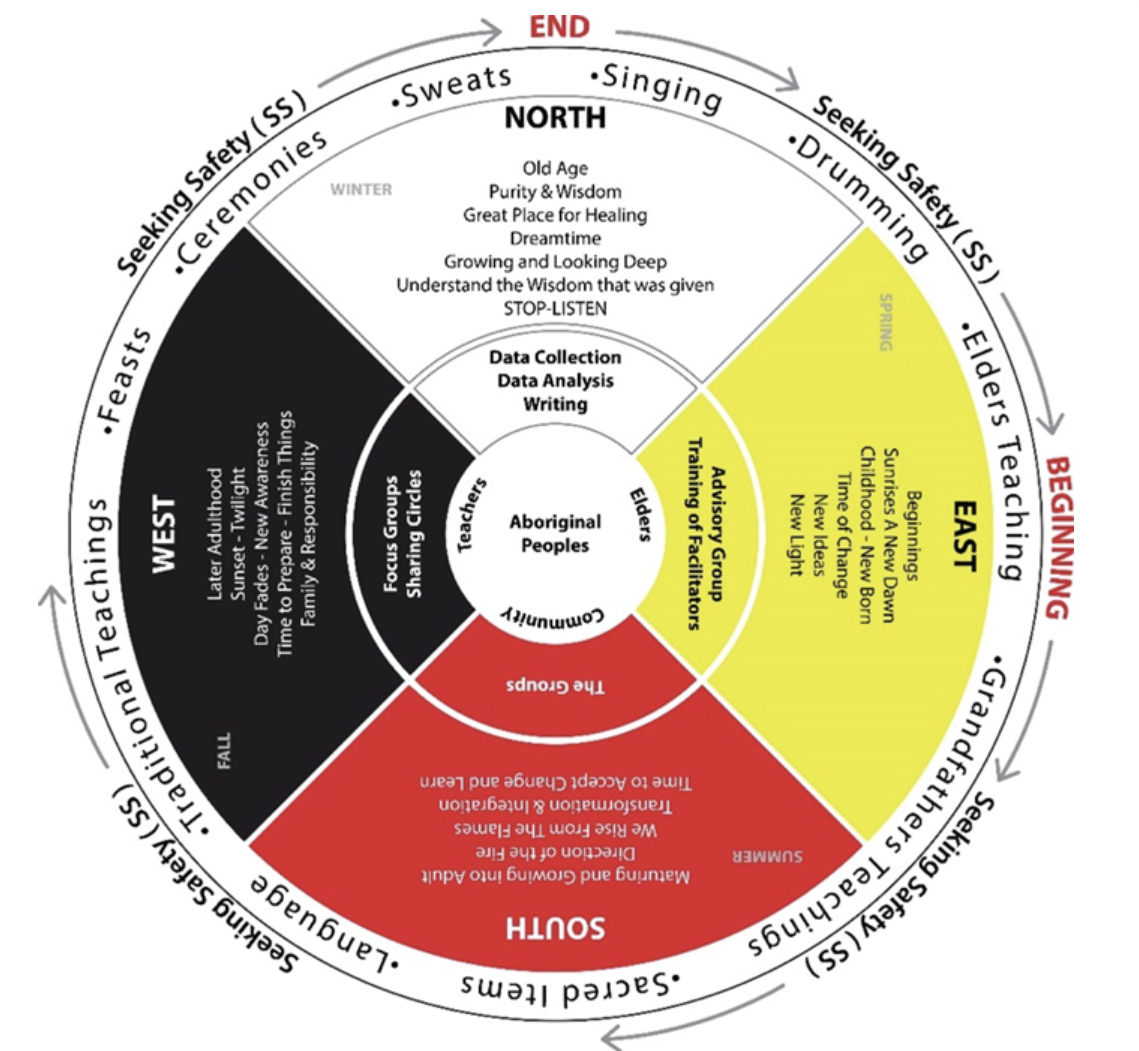
Nutritional experiments
Experiments
_____________ - these were done at a school in BC in 1948. exploited w/o proper consent and using vulnerabilities— done in residential schools, basically testing for the Canada Food Guide
Tri-Council Policy statement
_______________ - A Canadian ethical framework guiding research involving Indigenous Peoples, emphasizing decolonization, respect for self-determination, and meaningful community engagement.
It ensures research aligns with Indigenous values and priorities, moving away from exploitative practices.
OCAP principles
_______________ - Stands for:
Ownership
Control
Access
and Possession
a set of standards ensuring Indigenous communities retain authority over their data.
It mandates that research involving Indigenous Peoples must be community-led, with control over how information is collected, used, and shared.
Assembly of First Nations’ Ethics Guide
______________ - A resource outlining ethical research practices with Indigenous communities, emphasizing reciprocity, respect, and empowerment.
It challenges colonial research methods by prioritizing Indigenous leadership in study design and implementation.
Port Alberni milk experiment
Experiment
________________ - A historical unethical study at a residential school where researchers manipulated children’s milk intake without consent.
highlights the lack of ethical oversight and the harm caused by treating Indigenous Peoples as test subjects rather than human beings.
Newfoundland flour mix experiment
_____________ - A study at a boarding school where children were given mineral-fortified flour, resulting in declining health outcomes.
underscores the dangers of research on vulnerable populations without proper consent or ethical safeguard
CMA apology (2024)
______________ - The Canadian Medical Association’s public apology for failing to provide equitable care to Indigenous Peoples.
President Dr. Joss Reimer acknowledged systemic harms and committed to rebuilding trust through ethical medical practices.
Marsh et al. (2015)
Medicine wheel
______________ - who studied intergenerational trauma and substance use disorder among Indigenous Peoples in Northern Ontario using the two-eyed seeing approach – which, you’ll recall, blends Indigenous knowledge and Western science.
This approach included working with Elders, using sharing circles, and applying the Medicine Wheel to guide their research methods.
Two Schools of Thought in Indigenous research
Changing the research structure from within
Creating a new path foward
1) Changing the research structure from within
Two schools of thought in Indigenous research
___________ - An Indigenous research approach that seeks to reform existing academic frameworks by integrating Indigenous knowledge, values, and methods. It aims to make Western research practices more inclusive and respectful of Indigenous perspectives without entirely abandoning conventional systems.
2) Creating a new path forward
Two schools of thought in Indigenous research
___________ - An Indigenous research approach that rejects assimilation into Western frameworks and instead develops autonomous, community-led methodologies. It prioritizes Indigenous sovereignty, self-determination, and culturally rooted practices (e.g., oral traditions, ceremony-informed research).
Tri-Council Policy statement
Two schools of thought in Indigenous research → examples
____________ - Canada’s national ethical guideline for research involving humans, including Indigenous communities regarding research
It mandates free, prior, and informed consent, cultural sensitivity, and Indigenous leadership in research design and data ownership
University of Manitoba’s Indigenous research framework
Two schools of thought in Indigenous research → examples
____________ - A community-developed guideline for ethical engagement with First Nations, Métis, and Inuit Peoples.
Emphasizes reciprocity, respect, and Indigenous control over research processes, ensuring alignment with community priorities and knowledge systems.
Indigenous-led research and ethics
____________ - Should be:
Driven by the community itself
Centered on the needs and priorities of Indigenous Peoples
Focused on real-world action and solutions
Respectful of cultural traditions and values
Supportive of Indigenous control over their own data and information
Indigenous communities desire research communities that are:
Community-driven;
Self-determined;
Action-oriented;
Culturally responsive;
Uphold the Indigenous sovereignty of data and information.
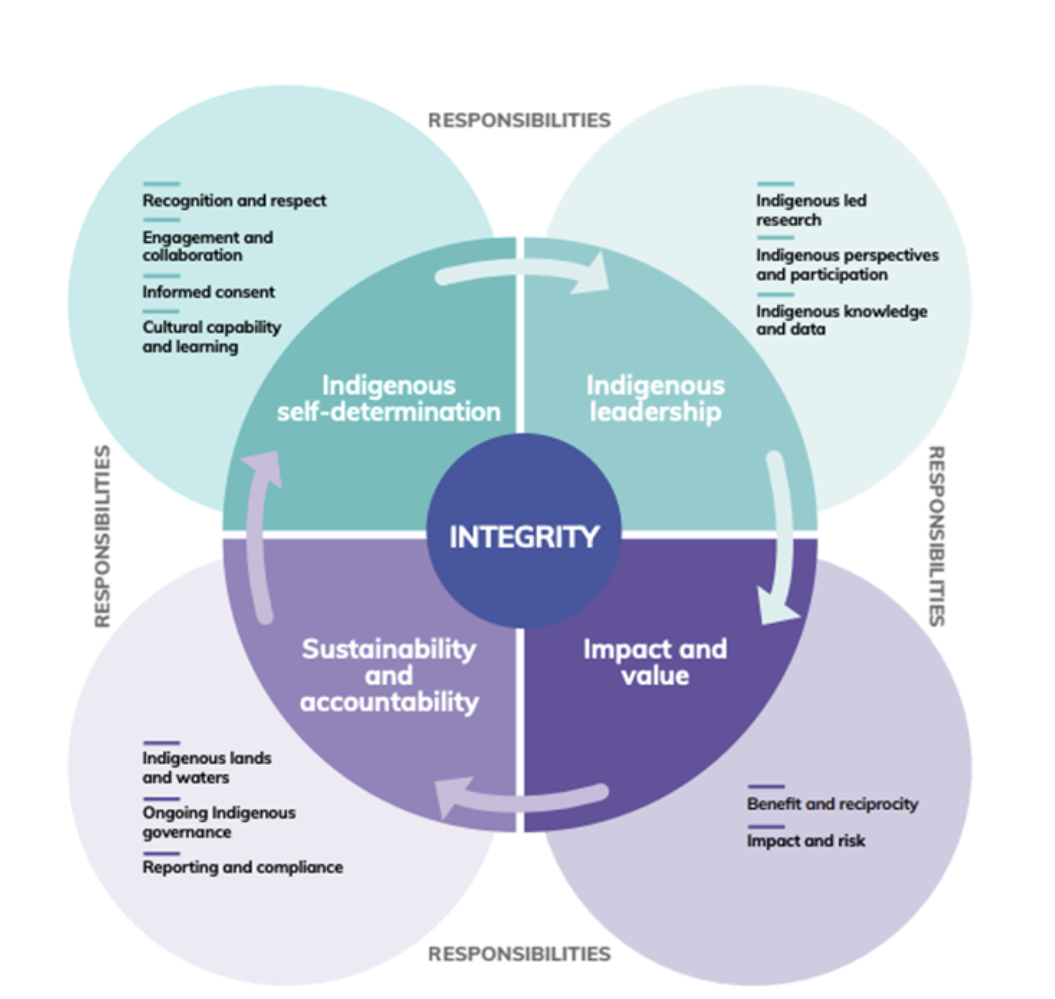
Five Rs of Indigenous research
_____________ - Est. by Cree scholar Verna Kirkness and Ray Barnhardt in their 1991 article, “First Nations and Higher Education: The Four Rs – Respect, Relevance, Reciprocity, Responsibility.”
Respect
Relevance
Reciprocity
Responsibility
Relationships
1) Respect
Five Rs of Indigenous research
________________ - Acknowledging and honoring Indigenous cultures, traditions, and knowledge systems.
2) Relevance
Five Rs of Indigenous research
________________ - Ensuring that research topics and methods align with the interests and needs of Indigenous communities.
3) Reciprocity
Five Rs of Indigenous research
________________ - Establishing mutual benefits in research, where both Indigenous and non-Indigenous communities gain from the process.
4) Responsibility
Five Rs of Indigenous research
________________ - Commitment to ethical practices and accountability to Indigenous communities and their knowledge.
5) Relationships
Five Rs of Indigenous research
________________ - Building and maintaining meaningful, reciprocal connections with Indigenous communities, emphasizing trust and mutual benefit.
Nature’s Way-Our Way Initiative
__________________ - stands for “NWOW”.
An Indigenous-led research project from the University of Saskatchewan focused on promoting children's physical literacy through culturally appropriate practices— bridges Indigenous knowledge systems with Western practices, involving collaboration between academic researchers, Elders, and Knowledge Holders from multiple First Nations communities.
Key features of NWOW
NWOW
Culturally Representative Activities: develops and implements physical literacy activities that are culturally relevant to Indigenous children, their families, and communities. These activities are designed to resonate with Indigenous values, traditions, and lifestyles.
Community Engagement: The initiative emphasizes participant engagement and collaboration with local communities, ensuring that the interventions are not only evidence-based but also reflective of community needs and contexts.
Implementation Science Approach: employs an implementation science approach that focuses on changing practices and behavioral patterns within early learning and childcare settings, ensuring that both Indigenous and non-Indigenous children benefit from the program.
Pilot Programs: The activities have been piloted in two urban early learning and childcare centers (ELCCs) that serve diverse populations, promoting inclusivity and shared learning experiences.
CPSA Protocols
__________________ - College of Physicians and Surgeons of Alberta’s guidelines establishing culturally competent healthcare standards for Indigenous communities in Alberta, emphasizing cultural safety, self-determination, and respectful engagement in medical practice.
Key features of the CPSA
CPSA
Cultural Competency: The CPSA emphasizes the need for healthcare professionals to develop cultural competency, ensuring they are well-equipped to provide care that respects Indigenous traditions and values.
Collaborative Engagement: These protocols encourage collaboration with local Indigenous organizations, promoting trust and mutual understanding between healthcare providers and Indigenous communities.
Focus on Self-Determination: Central to the CPSA’s guidelines is the principle of self-determination, empowering Indigenous Peoples to take an active role in their healthcare decisions and governance.
Evidence-Based Practices: The CPSA advocates for the integration of evidence-based practices that align with Indigenous knowledge systems, thereby enhancing the effectiveness of health interventions.
Holistic learning map
_______________
Start in the mind quadrant, considering new knowledge and concepts considered
Next to the body quadrant to reflect on how learnings engaged physical senses
Next to heart quadrant to explore emotional responses/connections to the material
Last contemplate the spirit quadrant to assess how your values/beliefs may have evolved or been challenged
Gathering sage
Traditional ceremonies → sage ceremony
__________ - a sacred traditional practice used for healing, first offering tobacco— this is the first step
A female practice - picking sage from a place of love and kindness, acknowledging the female body — caregiving, reproduction etc